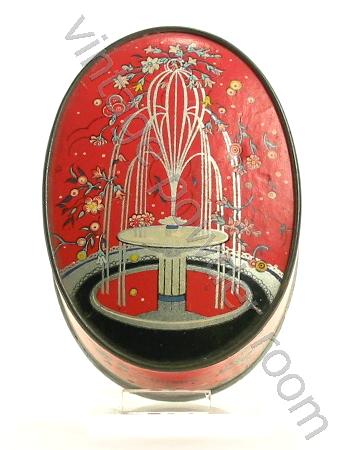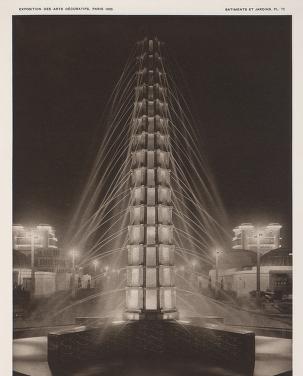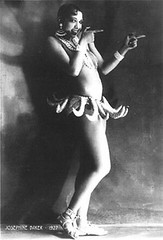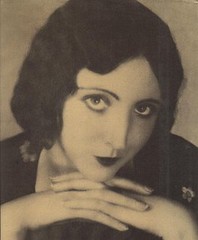Wed 6 Jan, 2010
FLAMINGO HAIR PINS
Comments (0) Filed under: Hair PinsTags: 1933 World's Fair, 1940s, 1947, 1950s, Al Capone, Black Dahlia, Bugsy Siegel, Charles Fischetti, Countess DiFrazzo, Elizabeth Short, flamingo, Frank Costello, Frank Nitti, Hans Hauser, Italy, Jake Guzik, Joe Adonis, Kefauver, Las Vegas, Lucky Luciano, Mafia, mobsters, Moe Sedway, murder, Noel Coward, Paris, red head, Virginia Hill, Wendy Barrie

When I’m looking through my collection trying to decide on a subject for a post, I rely on free association. According to Wikipedia free association is defined as:
“The method of free association has no linear or preplanned agenda, but works by intuitive leaps and linkages which may lead to new personal insights and meanings. “
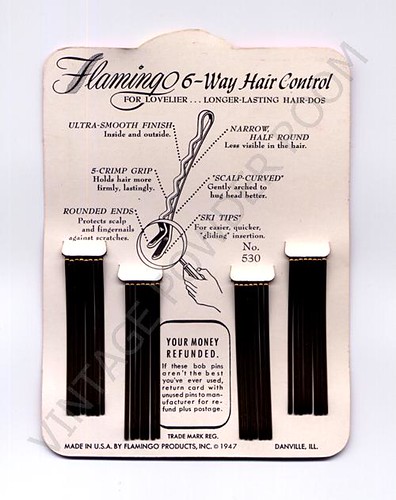
When I picked up the Flamingo hair pin card a few days ago and flipped it over, I saw that it was dated 1947. The first leap in my free association was to the Flamingo Hotel in Las Vegas, which I’d thought had opened in 1947 (actually it opened in December 1946). The next few associations I made were easy and seemed to me to be a natural progression: Benjamin “Bugsy” Siegel who was responsible for building the Flamingo Hotel (and was murdered in June 1947), Virginia Hill (Siegel’s mistress, nicknamed “Flamingo”), and last I thought of Elizabeth Short (aka the “Black Dahlia”) who was found murdered in Leimert Park in January 1947.
 Someone else may have thought of the lovely pink birds, but that’s just not how my mind works!
Someone else may have thought of the lovely pink birds, but that’s just not how my mind works!
Virginia Hill was a stunner. Red haired, vivacious and headstrong, she was bound to get attention from men. She was born in Alabama in 1916, and as a teenager she went to Chicago; however, it’s not clear if she went there to ply her trade as a prostitute at the 1933 World’s Fair, or work there as a dancer. In any case it was only a matter of time before she’d come to the attention of rich and powerful men looking for a little arm candy. In Chicago in 1933 the rich and powerful men were primarily mobsters, or politicians. She met Joseph Epstein, an associate of Jake “Greasy Thumb” Guzik (member of the Capone gang), and then she moved up through the mob hierarchy subsequently becoming mistress to Frank Costello, Frank Nitti, Charles Fischetti, and Joe Adonis.
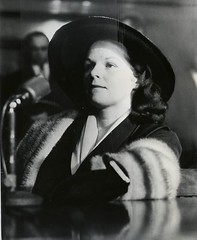
Virginia testifying at Kefauver hearings.
“She was smart and she knew how to keep her mouth shut,” said Bea Sedway, the wife of mobster Moe Sedway. Eventually Virginia’s smarts, and her tight lips, led her to become a courier for the mob. She’d deliver funds all over the country, and even make occasional trips to Switzerland with bags of cash for deposit in numbered bank accounts.
By 1940 Virginia had moved to Los Angeles where she met and fell for married wise guy Benjamin “Bugsy” Siegel. He would give her the nickname, “Flamingo”. The relationship between the mobster and his mistress was volatile and their fights were legendary. But they did make a handsome couple – the gorgeous red head and the mobster with the movie star looks.
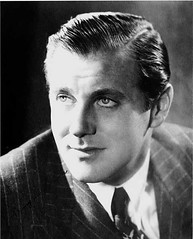
Ben Siegel
Ben had met his match in Virginia. She couldn’t stop his womanizing, but she knew how to hold his attention in a way that his other lovers did not. In a situation that could have come out of a Noel Coward comedy, Siegel once had three of his mistresses lodged simultaneously at the Flamingo Hotel: Virginia Hill, Wendy Barrie, and Countess DiFrasso. Virginia couldn’t abide the Countess and when she discovered that the woman was staying at the hotel she confronted her, and nearly broke her jaw. Virginia was definitely a tough broad. But then living and consorting with mobsters wouldn’t have appealed to a dame with a weaker constitution.
When Siegel became involved in building the Flamingo Hotel in Las Vegas it soon became clear that he wasn’t much of a businessman. Cost overruns were adding up at a reckless pace. The local contractors were robbing Ben, literally! They’d heist materials from the job site, and then re-sell them to Siegel at an enormous profit. While the contractors were stealing from Ben, Ben was stealing from the mob.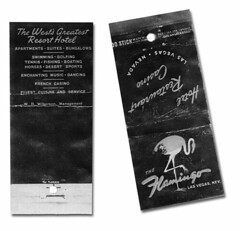
The Flamingo opened in December 1946. The weather was horrendous, and the hotel wasn’t even finished, so crowds of celebrities weren’t beating down the doors to get in. The big opening night was a total bust. Nursing a wounded ego, and fearing that the mob’s multi-million dollar investment in the hotel wouldn’t show a profit, Ben scurried off to Beverly Hills where he holed up in the house that Virginia rented there on 810 N. Linden Drive.
On the night of June 20, 1947 Ben would pay the price for his mismanagement of the Flamingo Hotel deal with his life. As Siegel sat with his associate Allen Smiley in Virginia’s Beverly Hills home reading the Los Angeles Times, an unknown assailant fired at him through the window with a .30-caliber military M1 carbine. He was hit several times – twice in the head. No one was charged with the murder, and the crime remains officially unsolved.
 Virginia was in Paris when she received the news of Ben’s death. It’s said that she fainted dead away. There would always be speculation about Virginia’s possible role in Ben’s assassination. But it’s highly unlikely that Virginia would have been tipped off about the plan to rub out Siegel, and even more doubtful that she’d have left one of her brothers in his company with the knowledge that a stray bullet could make him collateral damage.
Virginia was in Paris when she received the news of Ben’s death. It’s said that she fainted dead away. There would always be speculation about Virginia’s possible role in Ben’s assassination. But it’s highly unlikely that Virginia would have been tipped off about the plan to rub out Siegel, and even more doubtful that she’d have left one of her brothers in his company with the knowledge that a stray bullet could make him collateral damage.
The truth is that she and Ben had had an argument, and she stormed out in a huff and left for Paris. Any knowledge that Virginia may have had about the killing went with her to her grave. She’d been a mob gal for way too long not to understand that her best chance for survival was to keep quiet. In fact right after Ben’s murder she was denying everything, including being his lover: “If anyone or anything was his mistress, it was that Las Vegas hotel. I never knew Ben was involved in all that gang stuff. I can’t imagine who shot him or why,” she reportedly told the police.
In 1950, Virginia would take center stage at the Kefauver hearings. Senator Estes Kefauver headed a senate committee that was investigating organized crime. The hearings were even televised; introducing Mr. and Mrs. America for the first time to the Mafia. The televised hearings were compelling, but it was Virginia’s comments in the private sessions that would raise eyebrows.
She’d spent most of her time during the public hearings denying knowledge of, or involvement in, the rackets. But privately she was much more candid. She admitted to never having worked, and told the commission that she was able to survive on the generous gifts that were given to her by some of her admirers. Time magazine reported in its obituary of Hill on 1 April 1966, that Hill spent her time on the witness stand “boggling Senators with her full-grown curves and succinct explanation of just why men would lavish money on a hospitable girl from Bessemer, Alabama”.
What WAS her explanation for the gifts and money she received from mob big shots? According to Virginia it was her unparalleled skill at giving oral sex! Although I suspect Virginia would have phrased her explanation a little differently.
 Virginia would eventually settle in Europe with her third husband, a former Sun Valley ski instructor, Hans Hauser. She was trying to avoid the IRS, and probably some of her former mob acquaintances.
Virginia would eventually settle in Europe with her third husband, a former Sun Valley ski instructor, Hans Hauser. She was trying to avoid the IRS, and probably some of her former mob acquaintances.
By 1966 Virginia was broke, and it may have begun to occur to her to tell her story in a book or film. In 1962 retired mob boss Charles “Lucky” Luciano had reportedly considered a film deal and was supposed to meet with a producer at the airport in Naples, Italy; however, his famous luck ran out before the deal could be made. He died of a heart attack at the airport on January 26, 1962.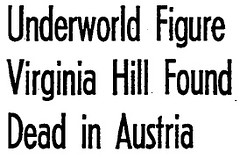
Maybe a visit she’d had from her former lover, Joe Adonis, days before her death was a meant to be a reminder that people don’t tell tales about the Mafia and live. Maybe their meeting was just the two ex-lovers chatting about old times. We’ll never know.
In March 1966, Virginia Hill’s body was found in a snow drift in Koppl, Austria. She’d allegedly taken an overdose of sleeping pills.
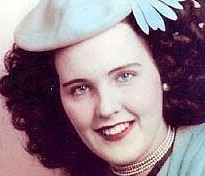 Oh, and before I forget – the last leap in my free association exercise led me to Elizabeth Short (aka the “Black Dahlia”). Her bisected body was discovered in a vacant lot in Leimert Park on January 15, 1947. Beth Short’s murder is arguably the most famous in Los Angeles’ history, and remains unsolved.
Oh, and before I forget – the last leap in my free association exercise led me to Elizabeth Short (aka the “Black Dahlia”). Her bisected body was discovered in a vacant lot in Leimert Park on January 15, 1947. Beth Short’s murder is arguably the most famous in Los Angeles’ history, and remains unsolved.
The reason I thought of Beth is simple, the 63rdanniversary of her murder is fast approaching; and as a tour guide for Esotouric, I’ll be a part of the “Real Black Dahlia” tour this coming Saturday, January 9th. I’ll be reading from some of the letters that Beth carried in her suitcase, as well as giving a thumbnail personality sketch of her that I’ve developed based upon her choice of make-up. For tour information visit Esotouric.com.
References:
- 1. Time Magazine
- 2. Los Angeles Times
- 3. Wikipedia
- 4. Tru TV Crime Library
